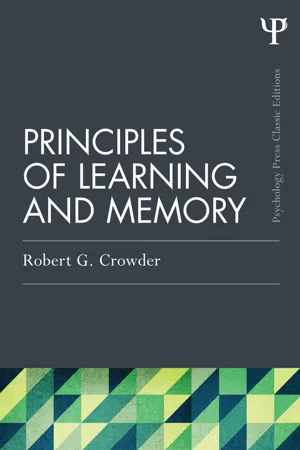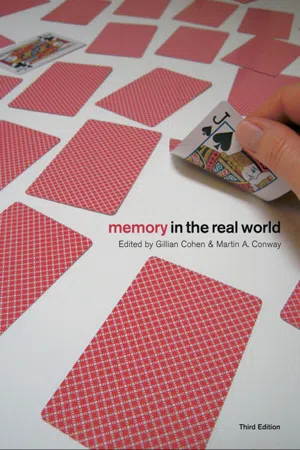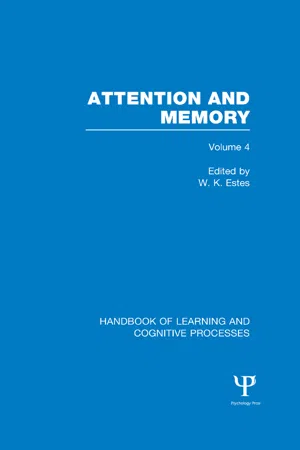Classic and Contemporary Research into Memory
"Classic and Contemporary Research into Memory" encompasses studies that have shaped our understanding of memory processes. Classic research, such as the work of Ebbinghaus and Bartlett, laid the foundation for our understanding of memory, while contemporary research continues to explore memory encoding, storage, and retrieval using advanced methodologies such as neuroimaging and cognitive neuroscience techniques.
5 Key excerpts on "Classic and Contemporary Research into Memory"
- eBook - ePub
- John Henderson(Author)
- 2005(Publication Date)
- Routledge(Publisher)
...Part II The Structure and Processes of Human Memory Pure Aspects 2 How do we study memory? DOI: 10.4324/9780203977651-2 Approaches to the study of memory There is no doubting the fact that our ability to remember information is an integral part of our lives. Even when we are not striving to remember a particular event, a person’s name, a fact for an examination or whatever, our day-to-day lives rely on constantly referring to our past and linking it to our present and our future. Whilst simply engaging in a conversation with a friend, we are required to produce and comprehend language at high speeds. For this we must access words, ideas and experiences from our memories and shape them into a series of sentences using a structure and grammar that is also represented in our permanent memories. Yet we do all this so effortlessly! The processes involved in accessing memories happen in an instant, and usually without our conscious awareness of them. This makes the scientific study of such processes highly problematical. Under everyday conditions we can merely speculate about how memories really work, and this is a frustration that is shared by those who theorise in all areas of cognitive psychology—thinking, perception, language and attention. Over the years, however, cognitive psychologists have made the best of the situation. Typically, they have adopted one of three general approaches to study, although sometimes these approaches have overlapped. They are, however, discussed individually. Computer approaches A rapidly expanding area in which psychologists are developing expertise is called cognitive science. Various aspects of cognition can be modelled by computer systems. A researcher might have a theory about how a given area of human cognition works, and may then develop a computer program to mimic this. In formation-processing models are popular in this respect...
- eBook - ePub
Principles of Learning and Memory
Classic Edition
- Robert G. Crowder(Author)
- 2014(Publication Date)
- Psychology Press(Publisher)
...The testing of neuropsychological patients led to many discoveries. Inspired by this research, many cognitive psychologists undertook the study of priming on implicit memory tests. For more than a decade they were fascinated by the fact that many variables that had powerful effects on explicit memory tests had no effects or even opposite effects on priming. The many other topics and phenomena are too numerous to mention without significant omissions, but consider the following partial list of terms that have mostly entered the lexicon since 1976: Autobiographical memory, collective memory, context-dependent memory, declarative and procedural memory, episodic and semantic memory, false memory, emotional memory, flashbulb memory, involuntary memory, metamemory, mood-dependent memory, prospective memory, recollected and familiar memories, social memory, spatial memory, state-dependent memory, transactive memory, trauma memories, unconscious memories, verbatim and gist memories and so on. (Many of these terms were taken from Tulving’s [2006] essay, “Are there 256 kinds of memory?”) Some terms just listed were briefly touched on in Principles of Learning and Memory, but the experimental efforts at understanding them came after 1976. Of course, this list does not include the new techniques that have been developed or the new memory phenomena discovered since then. In addition, the effort towards understanding the neural underpinnings of learning and memory via functional imaging methods was not even imaginable in 1976. Crowder’s great book provides an important historical marker of the field when the cognitive psychology movement was about 20 years old (if we date it from Miller’s [1956] paper in Psychological Review). It is interesting that Bob Crowder’s intellectual ancestor wrote one of the prior great textbooks in the field. John A. McGeoch wrote The Psychology of Human Learning. It was published in 1942, shortly after his untimely death...
- eBook - ePub
- G Neil Martin(Author)
- 2015(Publication Date)
- Routledge(Publisher)
...William James (1890), one of the founding fathers of modern psychology, was one of the earliest scientists to suggest that memory was made up of different systems. He proposed that memory comprised different elements called primary memory (memory for short-term processing) and secondary memory (long-term processing and storage). Over 60 years later, Broadbent (1958) specifically postulated short-term (STM) and long-term memory (LTM) processes in which items from STM would, via specific mechanisms, make their way into LTM. This was a significant dissociation at the time but, like most models in psychology, was later seen to be insufficient in explaining the range of human memory fully although these terms are still used today. The current literature is dominated by dichotomies of memory processes. One dichotomy is represented by declarative memory (Cohen and Squire, 1980), which refers to facts that are accessible to conscious recollection (the facts from this book, for example) and procedural memory, which refers to the skills and automatic operations needed to perform a certain function (e.g. the motor skills required for word processing or riding a bike). Another is between explicit and implicit memory, where explicit memory refers to the process of recalling material that is deliberately learned and retrieved, whereas implicit memory refers to the recall of material that may not be deliberately encoded or retrieved. Declarative memory is similar to explicit memory because it represents the conscious learning or memorisation of material. According to Squire (1994), declarative memory, 'refers to a biologically meaningful category of memory dependent on a specific brain system'. Some forms of memory, however, clearly do not fit the declarative memory description but, simultaneously, do not fit the definition of procedural memory particularly well either...
- eBook - ePub
- Gillian Cohen, Martin A. Conway, Gillian Cohen, Martin A. Conway(Authors)
- 2007(Publication Date)
- Psychology Press(Publisher)
...It is also thought to be earlier in both evolutionary and ontogenetic terms, and represents a sort of reservoir of memory that is better able to survive trauma and to resist the effects of ageing. CHARACTERISTICS OF MEMORY PROCESSES Types of memory process Recent work has concentrated more on the nature of memory representations, so that the importance of memory processes has been underplayed. Most of the characteristics of the memory system that have been outlined so far are ones that have the effect of easing the burden on storage and placing greater demands on retrieval processes. Many other types of process are involved: memories that are dynamic need to be assembled; processes of transformation may be needed to rotate, align, expand, or contract the internal analogues we construct of the real world; processes of selection, abstraction, and generalisation are needed to protect the system from overload. Hypothetical representations have to be constructed, and indirectly represented information has to be recovered by inferential processes. Complex matching processes are required to integrate new information with representations of past experience, and in order to perceive analogies between current problems and previously encountered ones. Elaborative encoding relies on processes of association and matching. All these processes need a temporary storage system like working memory, which can maintain information in consciousness while these operations are taking place. Metalevels of memory Metalevels of memory are needed to instigate, monitor, and control memory processes. The operations of working memory need to be driven by some form of central executive or supervisory attentional system linking memory to goals and actions. Retrieval from long-term memory is facilitated by metamemory awareness of what knowledge is in store and what kind of search strategies are most likely to be effective. Memories are more useful if people can make judgements about their accuracy...
- eBook - ePub
Handbook of Learning and Cognitive Processes (Volume 4)
Attention and Memory
- William Estes(Author)
- 2014(Publication Date)
- Psychology Press(Publisher)
...3 The Concept of Primary Memory Fergus I. M. Craik University of Toronto Betty Ann Levy McMaster University I. INTRODUCTION The idea that memory can be divided into two main compartments or processes has appeared in various forms in human experimental psychology over the last hundred years. The basic distinction has been between memory for material presented recently and memory for material acquired some time in the past. Most often, the labels “short-term memory” (STM) and “long-term memory” (LTM) have been used to describe these compartments, but the terms (especially “short-term memory”) have been used in such a wide variety of ways that the more precise terminology “primary memory” (PM) and “secondary memory” (SM) (Waugh & Norman, 1965) will be used here. Although the distinction between two memory systems has been widely recognized, there is remarkably little agreement on the best way to describe primary memory: Is PM a separate store, a different type of trace, a special type of retrieval cue, an attention-like process, or some mixture of these structures and processes? This chapter evaluates the various suggestions by examining theoretical notions and empirical data engendered by each view. Before turning to these issues, however, the terminology of the area is discussed and the historical background sketched. A Discussion of Terminology One major source of difficulty in following the literature on human short-term memory is the proliferation of terms. To add to the confusion, the different labels often refer to very similar concepts; also, the precise usage can vary from one writer to the next. It may be useful, before reviewing the area, to point out terms which are more or less equivalent, and to show how one set of descriptions relates to the others. Basically, four different types of description are entangled in the terminology...




